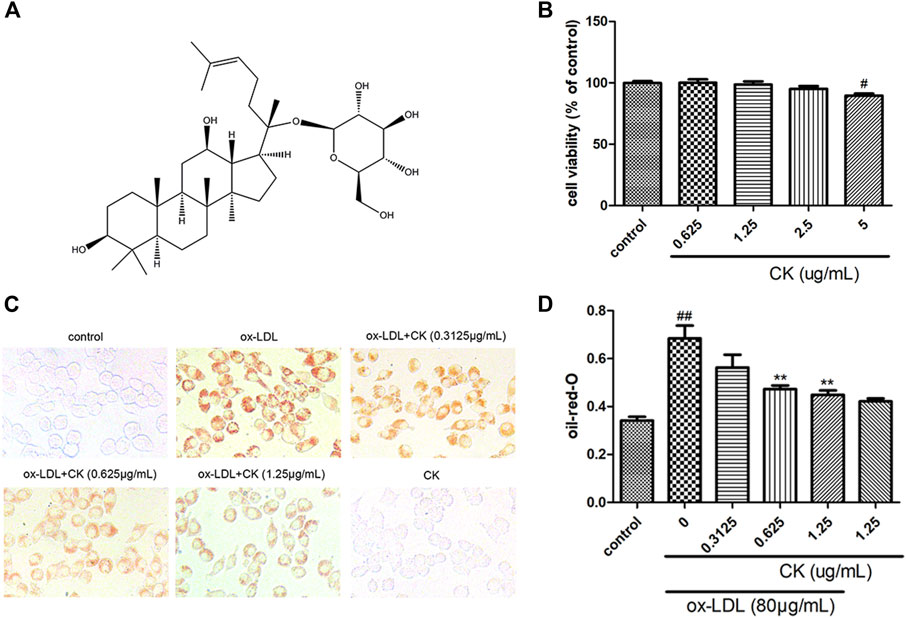Ginsenoside Compound K Attenuates Ox-LDL-Mediated Macrophage Inflammation and Foam Cell Formation via Autophagy Induction and Modulating NF-κB, p38, and JNK MAPK Signaling
- 1Institute of Medicinal Plant Development, Peking Union Medical College and Chinese Academy of Medical Sciences, Beijing, China
- 2Institute of Medicinal Plant Development, Beijing Key Laboratory of Innovative Drug Discovery of Traditional Chinese Medicine (Natural Medicine) and Translational Medicine, Beijing, China
- 3Key Laboratory of Bioactive Substances and Resource Utilization of Chinese Herbal Medicine, Ministry of Education, Beijing, China
- 4Key Laboratory of Efficacy Evaluation of Chinese Medicine Against Glyeolipid Metabolism Disorder Disease, State Administration of Traditional Chinese Medicine, Beijing, China
- 5Key Laboratory of New Drug Discovery Based on Classic Chinese Medicine Prescription, Chinese Academy of Medical Sciences, Beijing, China
by Lu S, Luo Y, Sun G and Sun X (2020). Front. Pharmacol. 11:567238. doi: 10.3389/fphar.2020.567238
In the published article, there was an error in Figure 1 as published. In Figure 1C, the representative pictures in the control and CK groups were the same as in one of our previously published papers. The corrected Figure 1 and its caption appear below.

Figure 1. CK inhibited ox-LDL-induced RAW264.7 cells lipid accumulation. RAW264.7 cells were treated with CK at various concentrations for 12 h with or without 80 mg/mL ox-LDL for additional 24 h. (A) The chemical formula for CK. (B) Cell viability was assayed by the MTT assay. (C) Representative images of Oil Red O staining. (D) Oil red O positive area was measured by ImageJ software. All data are shown as mean ± SD from three independent experiments with each performed in triplicate. #p < 0.05, ##p < 0.01 vs. control group; **p < 0.01 vs. ox-LDL-treated group. CK, compound K; ox-LDL, oxidized low-density lipoprotein; MTT, (4, 5-dimethylthiazol-2yl-)-2,5-diphenyl tetrazolium bromide.
The authors apologize for this error and state that this does not change the scientific conclusions of the article in any way. The original article has been updated.
Publisher’s note
All claims expressed in this article are solely those of the authors and do not necessarily represent those of their affiliated organizations, or those of the publisher, the editors and the reviewers. Any product that may be evaluated in this article, or claim that may be made by its manufacturer, is not guaranteed or endorsed by the publisher.
Keywords: atherosclerosis, Ginsenoside compound K, inflammation, autophagy, macrophage
Citation: Lu S, Luo Y, Sun G and Sun X (2024) Corrigendum: Ginsenoside compound K attenuates ox-LDL-mediated macrophage inflammation and foam cell formation via autophagy induction and modulating NF-kB, p38, and JNK MAPK signaling. Front. Pharmacol. 15:1452605. doi: 10.3389/fphar.2024.1452605
Received: 21 June 2024; Accepted: 11 July 2024;
Published: 23 July 2024.
Edited and reviewed by:
Galina Sud’ina, Lomonosov Moscow State University, RussiaCopyright © 2024 Lu, Luo, Sun and Sun. This is an open-access article distributed under the terms of the Creative Commons Attribution License (CC BY). The use, distribution or reproduction in other forums is permitted, provided the original author(s) and the copyright owner(s) are credited and that the original publication in this journal is cited, in accordance with accepted academic practice. No use, distribution or reproduction is permitted which does not comply with these terms.
*Correspondence: GuiBo Sun, c3VuZ3VpYm9AMTI2LmNvbQ==; XiaoBo Sun, c3VuX3hpYW9ibzE2M0AxNjMuY29t
†These authors have contributed equally to this work
 Shan Lu
Shan Lu Yun Luo
Yun Luo GuiBo Sun
GuiBo Sun XiaoBo Sun
XiaoBo Sun